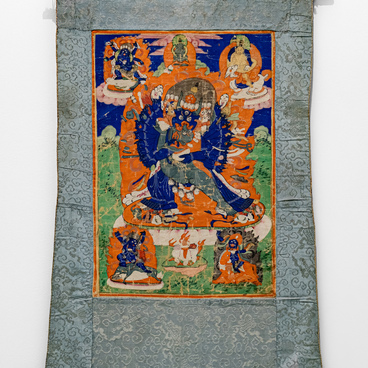Mongolian Buddhist iconography originated and was formed as a result of intercultural and interethnic interactions (India, China, Tibet) incorporating a wide range of many practices and customs, including those that came from shamanism and primitive beliefs. In this sense, the cult of Dalha has its historical roots in the indigenous beliefs of the Mongolian peoples and was adapted by Buddhism as one of the early forms of religion among the peoples of Central Asia.
Dalhas are deities of pre-Buddhist origin. They belong to a group of Central Asian cults assimilated by Buddhism in ancient times in Tibet. In Tibetan mythology, the Lha are supernatural entities, the supreme deities who control the celestial spheres. “Lha” translates from Tibetan as “god.” They are referred to as both celestial and mountain deities. Dalha is not a name of a single deity, it is a collective term denoting the category of deities and spirits who patronize people. There are groups of 3, 5, 7, 9, 13, and 21 Dalhas. They are often found in Mongolian and Buryat thangkas.
In the central vertical row of the thangka, a follower of the teaching can see the idea of the myth of the nine Dalhas and all its characters. The nine brothers (companions) of Dalha are revered by Tibetans and Mongolian peoples as patrons of warriors. They are depicted riding horses. Their weapons are of celestial origin, so they are considered invincible. All nine brothers are depicted as horsemen in military armor. Thus, the cult of the nine Dalhas undoubtedly carries the idea of ensuring victorious campaigns that bring expensive trophies, suppressing the enemy, protecting the strength and abilities of a male warrior, securing the fighting qualities of horses, reliability and durability of weapons.
As the guardian of the warlords and warriors of the
Mongol army, Dalha is associated with the god of war Sülde and was introduced
into the revered pantheon of Buddhist gods. Dalha, in the guise of an older
brother and commander, is depicted in the center against the background of
tongues of fire on a white horse. As the eldest, he is depicted larger in size
than the other eight brothers, whom the iconographer places on the left and
right sides of the central figure. In the center of the upper edge of the icon
is the deity Vajrapani, whose emanation is the central character. His tense
posture resembles a “ready to fight” position. In his right hand he holds a
mythological weapon — a vajra. According to the iconographic canon, the lower
part of the icon depicts sacrificial offerings that should be presented to the
Dalha in order to receive his support.


